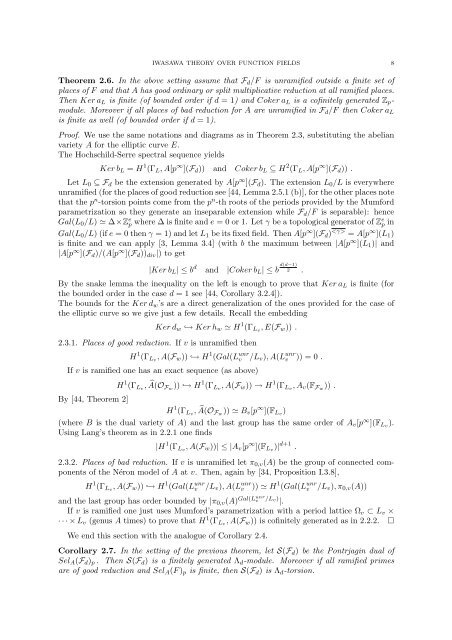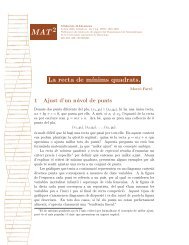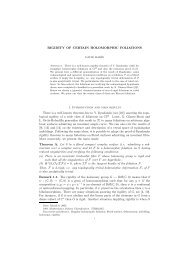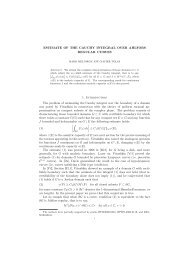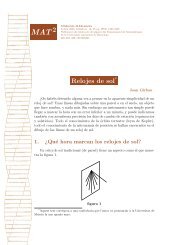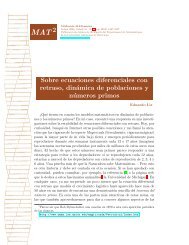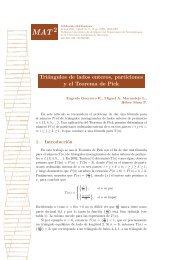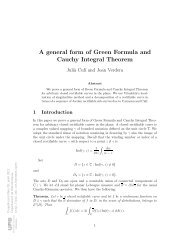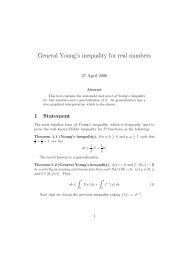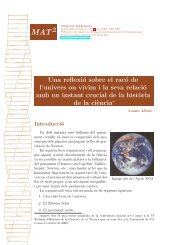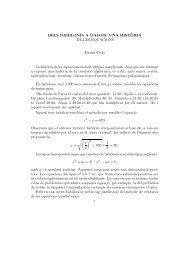ASPECTS OF IWASAWA THEORY OVER FUNCTION FIELDS 1 ...
ASPECTS OF IWASAWA THEORY OVER FUNCTION FIELDS 1 ...
ASPECTS OF IWASAWA THEORY OVER FUNCTION FIELDS 1 ...
You also want an ePaper? Increase the reach of your titles
YUMPU automatically turns print PDFs into web optimized ePapers that Google loves.
<strong>IWASAWA</strong> <strong>THEORY</strong> <strong>OVER</strong> <strong>FUNCTION</strong> <strong>FIELDS</strong> 8Theorem 2.6. In the above setting assume that F d /F is unramified outside a finite set ofplaces of F and that A has good ordinary or split multiplicative reduction at all ramified places.Then Ker a L is finite (of bounded order if d = 1) and Coker a L is a cofinitely generated Z p -module. Moreover if all places of bad reduction for A are unramified in F d /F then Coker a Lis finite as well (of bounded order if d = 1).Proof. We use the same notations and diagrams as in Theorem 2.3, substituting the abelianvariety A for the elliptic curve E.The Hochschild-Serre spectral sequence yieldsKer b L = H 1 (Γ L , A[p ∞ ](F d )) and Coker b L ⊆ H 2 (Γ L , A[p ∞ ](F d )) .Let L 0 ⊆ F d be the extension generated by A[p ∞ ](F d ). The extension L 0 /L is everywhereunramified (for the places of good reduction see [44, Lemma 2.5.1 (b)], for the other places notethat the p n -torsion points come from the p n -th roots of the periods provided by the Mumfordparametrization so they generate an inseparable extension while F d /F is separable): henceGal(L 0 /L) ≃ ∆×Z e p where ∆ is finite and e = 0 or 1. Let γ be a topological generator of Z e p inGal(L 0 /L) (if e = 0 then γ = 1) and let L 1 be its fixed field. Then A[p ∞ ](F d ) = A[p ∞ ](L 1 )is finite and we can apply [3, Lemma 3.4] (with b the maximum between |A[p ∞ ](L 1 )| and|A[p ∞ ](F d )/(A[p ∞ ](F d )) div |) to get|Ker b L | ≤ b d and |Coker b L | ≤ b d(d−1)2 .By the snake lemma the inequality on the left is enough to prove that Ker a L is finite (forthe bounded order in the case d = 1 see [44, Corollary 3.2.4]).The bounds for the Ker d w ’s are a direct generalization of the ones provided for the case ofthe elliptic curve so we give just a few details. Recall the embeddingKer d w ↩→ Ker h w ≃ H 1 (Γ Lv , E(F w )) .2.3.1. Places of good reduction. If v is unramified thenH 1 (Γ Lv , A(F w )) ↩→ H 1 (Gal(L unrv /L v ), A(L unrv )) = 0 .If v is ramified one has an exact sequence (as above)By [44, Theorem 2]H 1 (Γ Lv , Â(O F w)) ↩→ H 1 (Γ Lv , A(F w )) → H 1 (Γ Lv , A v (F Fw )) .H 1 (Γ Lv , Â(O F w)) ≃ B v [p ∞ ](F Lv )(where B is the dual variety of A) and the last group has the same order of A v [p ∞ ](F Lv ).Using Lang’s theorem as in 2.2.1 one finds|H 1 (Γ Lv , A(F w ))| ≤ |A v [p ∞ ](F Lv )| d+1 .2.3.2. Places of bad reduction. If v is unramified let π 0,v (A) be the group of connected componentsof the Néron model of A at v. Then, again by [34, Proposition I.3.8],H 1 (Γ Lv , A(F w )) ↩→ H 1 (Gal(L unrv/L v ), A(L unrv)) ≃ H 1 (Gal(L unrv /L v ), π 0,v (A))and the last group has order bounded by |π 0,v (A) Gal(Lunr v /L v) |.If v is ramified one just uses Mumford’s parametrization with a period lattice Ω v ⊂ L v ×· · · × L v (genus A times) to prove that H 1 (Γ Lv , A(F w )) is cofinitely generated as in 2.2.2. □We end this section with the analogue of Corollary 2.4.Corollary 2.7. In the setting of the previous theorem, let S(F d ) be the Pontrjagin dual ofSel A (F d ) p . Then S(F d ) is a finitely generated Λ d -module. Moreover if all ramified primesare of good reduction and Sel A (F ) p is finite, then S(F d ) is Λ d -torsion.


